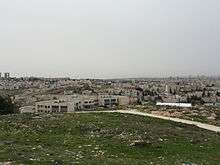Gibeah
Coordinates: 31°49′24.14″N 035°13′52.14″E / 31.8233722°N 35.2311500°E Gibeah (/ˈɡɪbiə/; Hebrew: גבעה Giv'a) is a place name appearing in several books of the Bible. It is generally identified with a hill in Jerusalem, on the outskirts of the Pisgat Ze'ev and Shuafat neighborhoods, known as Tell el-Ful.[1] However, this identification was challenged by Israel Finkelstein in 2011.[2]
Etymology
Gibeah may be a variation of the Hebrew word meaning “hill,” other names include Gibeah of God (גִּבְעַת הָאֱלֹהִים)[3] Gibeah of Benjamin (גִּבְעַת בִּנְיָמִין) for it is in the territory of the Tribe of Benjamin[4] and Gibeah of Saul (גִּבְעַת שָׁאוּל) where the biblical King Saul lived.[5]
Geography
Gibeah is believed to be located along the Central Benjamin Plateau, 3 miles (4.8 km) north of Jerusalem along the Watershed Ridge at 2,754 feet (839 m) above sea level.
History
- Benjamin allotment - Joshua 18:28
- Awarta is the Gibeah of Phinehas and the burial place of his father, Eleazar, the son of Aaron - Joshua 24:33
- The Turning Out of the Concubine of Gibeah, and the Battle of Gibeah - (Israelite Civil War) - Judges 19-21
- Israel’s first king, King Saul, reigned from Gibeah for 38 years - 1 Samuel 8-31
- Prophetic mention during the period of the Divided Kingdom - Hosea 5:8, 9:9, 10:9; Isaiah 10:29
- The 10th Roman Legion camped here in their assault on Jerusalem in 70 A.D. - Josephus, War of the Jews
- King Hussein of Jordan began construction on his Royal Palace in Tel el-Ful, but construction was halted when the Six-Day War broke out. Since Israel won the war King Hussein's palace was never finished and now all that remains is the skeleton of the building.

Archaeology
The site was first excavated in 1868 by Charles Warren, while C.R. Conder described the remains in 1874. William F. Albright led his first excavation from 1922 to 1923, and returned for a second season in 1923. His work was published in 1960. P.W. Lapp conducted a six-week salvage excavation in 1964. According to Kenneth Kitchen "Upon this strategic point was found an Iron I occupation replaced (at an interval) by a fortress ("I"), subsequently refurbished ("II"), and then later in disuse. The oldest level may reflect the Gibeah of Judg 19-20. The excavations by Albright, checked by Lapp, would favor the view that it was Saul who built the first fortress, later repaired by him or David. the first fort (quadrangular) had at least one rectangular corner-tower at its southwest angle; it may have had others at the other corners, but no traces were detected."[6]
See also
References
- ↑ Discovering the World of the Bible By LaMar C. Berrett
- ↑ Israel Finkelstein (2011). "Tell el-Ful revisited: The Assyrian and Hellenistic periods (with a new identification)". Palestine Exploration Quarterly 143 (2): 106–118. doi:10.1179/003103211x12971861556918.
- ↑ 1 Samuel 10,5
- ↑ 1 Samuel 13,2 13,15 14,16
- ↑ 1 Samuel 11,4 15,34 Isaiah 10,29
- ↑ Kenneth Kitchen, On the Reliability of the Old Testament (Grand Rapids: Eerdmans), p. 97.
Further reading
- P. Arnold, Gibeah, Anchor Bible Dictionary (1992).
- N. Lapp, Tel el-Ful, Oxford Encyclopedia of Archaeology in the Near East (1997).
- L. A. Sinclair, An Archaeological Study of Gibeah (1960).
- W. F. Albright, The Archeology of Palestine (1971).
| Wikimedia Commons has media related to Gibeah. |
|